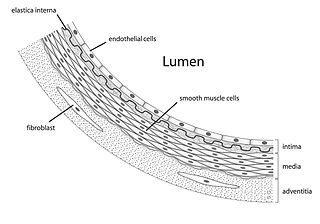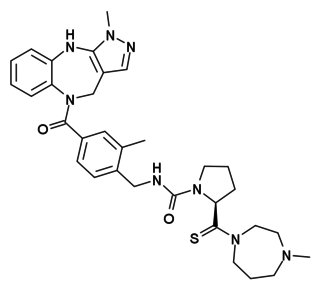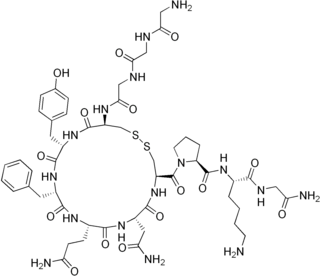
Acetylcholine (ACh) is an organic chemical that functions in the brain and body of many types of animals, including humans, as a neurotransmitter—a chemical message released by nerve cells to send signals to other cells [neurons, muscle cells, and gland cells]. Its name is derived from its chemical structure: it is an ester of acetic acid and choline. Parts in the body that use or are affected by acetylcholine are referred to as cholinergic. Substances that interfere with acetylcholine activity are called anticholinergics. Acetylcholine is the neurotransmitter used at the neuromuscular junction—in other words, it is the chemical that motor neurons of the nervous system release in order to activate muscles. This property means that drugs that affect cholinergic systems can have very dangerous effects ranging from paralysis to convulsions. Acetylcholine is also a neurotransmitter in the autonomic nervous system, both as an internal transmitter for the sympathetic nervous system and as the final product released by the parasympathetic nervous system.

Oxytocin (Oxt) is a peptide hormone and neuropeptide. Oxytocin is normally produced in the hypothalamus and released by the posterior pituitary. It plays a role in social bonding, sexual reproduction, childbirth, and the period after childbirth. Oxytocin is released into the bloodstream as a hormone in response to stretching of the cervix and uterus during labor and with stimulation of the nipples from breastfeeding. This helps with birth, bonding with the baby, and milk production. Oxytocin was discovered by Henry Dale in 1906. Its molecular structure was determined in 1952. Oxytocin is also used as a medication to facilitate childbirth.

The adrenergic receptors or adrenoceptors are a class of G protein-coupled receptors that are targets of many catecholamines like norepinephrine (noradrenaline) and epinephrine (adrenaline) produced by the body, but also many medications like beta blockers, β2 agonists and α2 agonists, which are used to treat high blood pressure and asthma for example.

Vascular smooth muscle refers to the particular type of smooth muscle found within, and composing the majority of the wall of blood vessels.

Conivaptan is a non-peptide inhibitor of the receptor for anti-diuretic hormone, also called vasopressin. It was approved in 2004 for hyponatremia. The compound was discovered by Astellas and marked in 2006. The drug is now marketed by Cumberland Pharmaceuticals, Inc.

Vasopressin receptor 1A (V1AR), or arginine vasopressin receptor 1A is one of the three major receptor types for vasopressin, and is present throughout the brain, as well as in the periphery in the liver, kidney, and vasculature.

Vasopressin V1b receptor (V1BR) also known as vasopressin 3 receptor (VPR3) or antidiuretic hormone receptor 1B is a protein that in humans is encoded by the AVPR1B gene.
The alpha-2 (α2) adrenergic receptor is a G protein-coupled receptor (GPCR) associated with the Gi heterotrimeric G-protein. It consists of three highly homologous subtypes, including α2A-, α2B-, and α2C-adrenergic. Some species other than humans express a fourth α2D-adrenergic receptor as well. Catecholamines like norepinephrine (noradrenaline) and epinephrine (adrenaline) signal through the α2-adrenergic receptor in the central and peripheral nervous systems.
The actions of vasopressin are mediated by stimulation of tissue-specific G protein-coupled receptors (GPCRs) called vasopressin receptors that are classified into the V1 (V1A), V2, and V3 (V1B) receptor subtypes. These three subtypes differ in localization, function and signal transduction mechanisms.

Vasotocin is an oligopeptide homologous to oxytocin and vasopressin found in all non-mammalian vertebrates and possibly in mammals during the fetal stage of development. Arginine vasotocin (AVT), a hormone produced by neurosecretory cells within the posterior pituitary gland (neurohypophysis) of the brain, is a major endocrine regulator of water balance and osmotic homoeostasis and is involved in social and sexual behavior in non-mammalian vertebrates. In mammals, it appears to have biological properties similar to those of oxytocin and vasopressin. It has been found to have effects on the regulation of REM sleep. Evidence for the existence of endogenous vasotocin in mammals is limited and no mammalian gene encoding vasotocin has been confirmed.

The oxytocin receptor, also known as OXTR, is a protein which functions as receptor for the hormone and neurotransmitter oxytocin. In humans, the oxytocin receptor is encoded by the OXTR gene which has been localized to human chromosome 3p25.

FG-7142 (ZK-31906) is a drug which acts as a partial inverse agonist at the benzodiazepine allosteric site of the GABAA receptor. It has anorectic, anxiogenic and pro-convulsant effects. It also increases release of acetylcholine and noradrenaline, and improves memory retention in animal studies.

Beta adrenergic agonists or beta agonists are medications that relax muscles of the airways, which widen the airways and result in easier breathing. They are a class of sympathomimetic agents which act upon the beta adrenoceptors. In general, pure beta-adrenergic agonists have the opposite function of beta blockers. Beta adrenoreceptor agonist ligands mimic the action of epinephrine and norepinephrine signaling in the heart, lungs, and smooth muscle tissue, with epinephrine expressing the highest affinity. The activation of β1, β2 and β3 activates the enzyme, adenylate cyclase. This, in turn, leads to the activation of the secondary messenger cyclic adenosine monophosphate (cAMP), cAMP then activates protein kinase A (PKA) which phosphorylates target proteins, ultimately inducing smooth muscle relaxation and contraction of the cardiac tissue.

U46619 is a stable synthetic analog of the endoperoxide prostaglandin PGH2 first prepared in 1975, and acts as a thromboxane A2 (TP) receptor agonist. It potently stimulates TP receptor-mediated, but not other prostaglandin receptor-mediated responses in various in vitro preparations. and exhibits many properties similar to thromboxane A2, including shape change and aggregation of platelets and smooth muscle contraction. U46619 is a vasoconstrictor that mimics the hydroosmotic effect of vasopressin.

WAY-267464 is a potent, selective, non-peptide agonist for the oxytocin receptor, with negligible affinity for the vasopressin receptors. Contradictorily however, though originally described as selective for the oxytocin receptor and lacking affinity for the vasopressin receptors, it has since been reported to also act as a potent vasopressin V1A receptor antagonist. WAY-267464 has been shown to cross the blood-brain-barrier to a significantly greater extent than exogenously applied oxytocin, and in animal tests produces centrally-mediated oxytocinergic actions such as anxiolytic effects, but with no antidepressant effect evident. It was developed by a team at Ferring Pharmaceuticals.

U-69,593 is a drug which acts as a potent and selective κ1-opioid receptor agonist. In animal studies it has been shown to produce antinociception, anti-inflammation, anxiolysis, respiratory depression, and diuresis, while having little effect on gastrointestinal motility. It also inhibits the peripheral, though not central secretion of oxytocin and vasopressin in rats.

TC OT 39 is a non-peptide partial agonist of the oxytocin and vasopressin V2 receptors (Ki = 147 nM and >1000 nM, respectively) and antagonist of the vasopressin V1A receptor (Ki = 330 nM).

A prolactin modulator is a drug which modulates the secretion of the pituitary hormone prolactin from the anterior pituitary gland. Prolactin inhibitors suppress and prolactin releasers induce the secretion of prolactin, respectively.




















